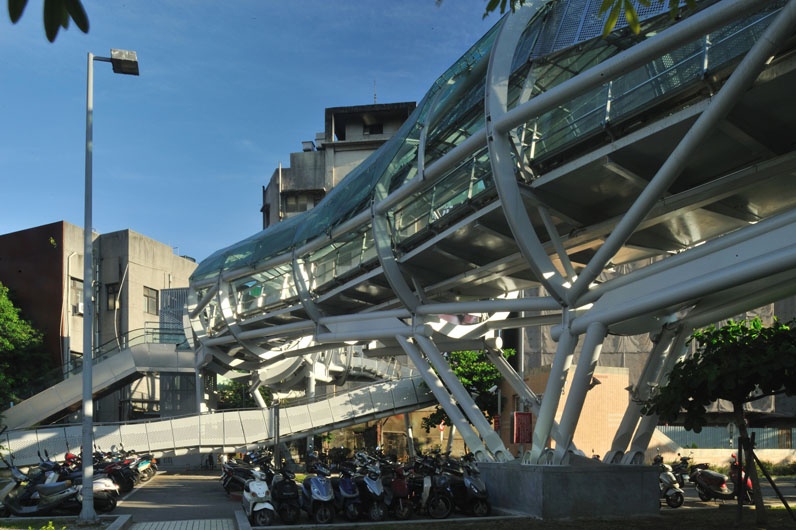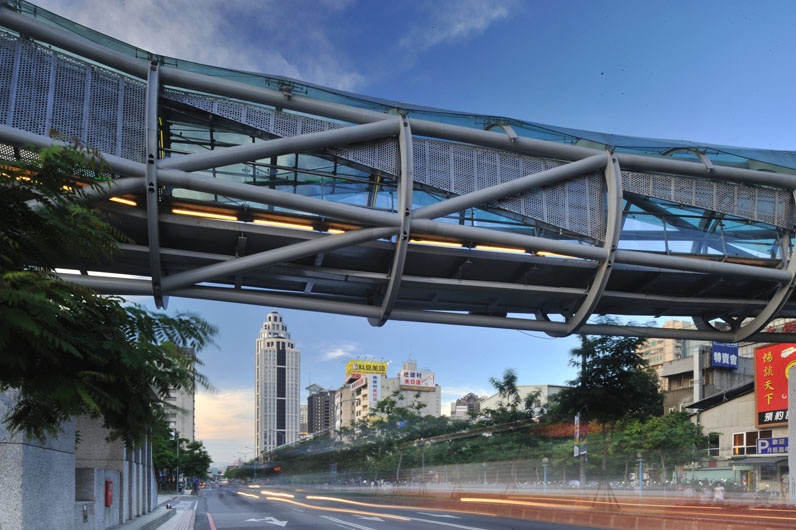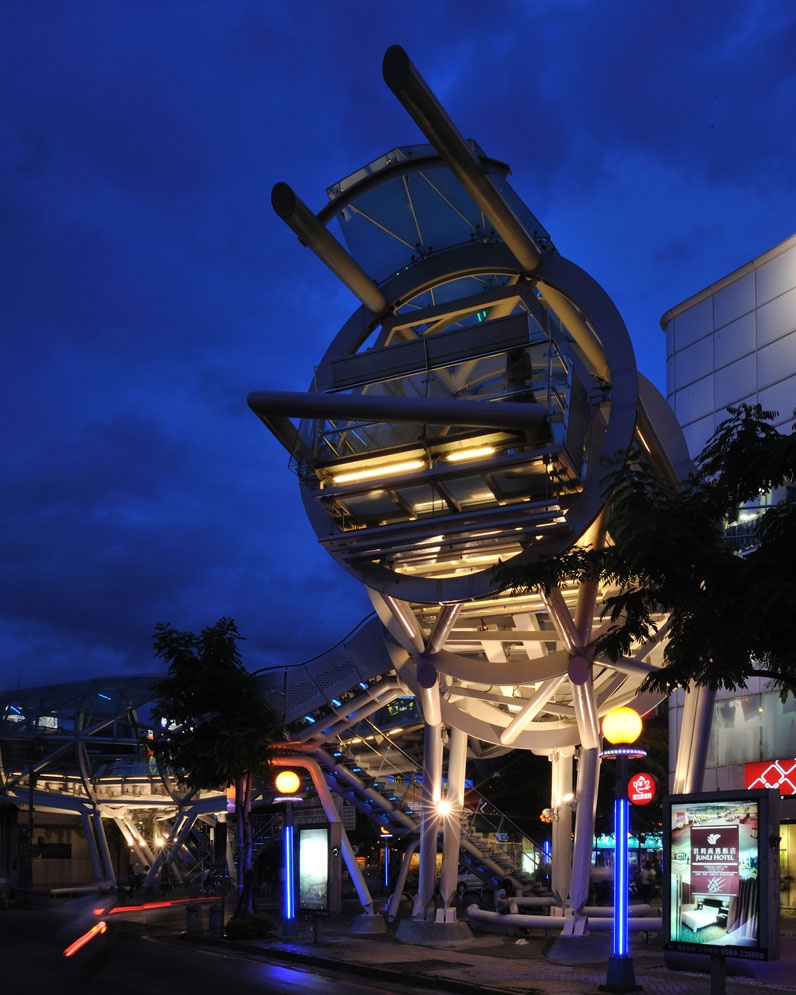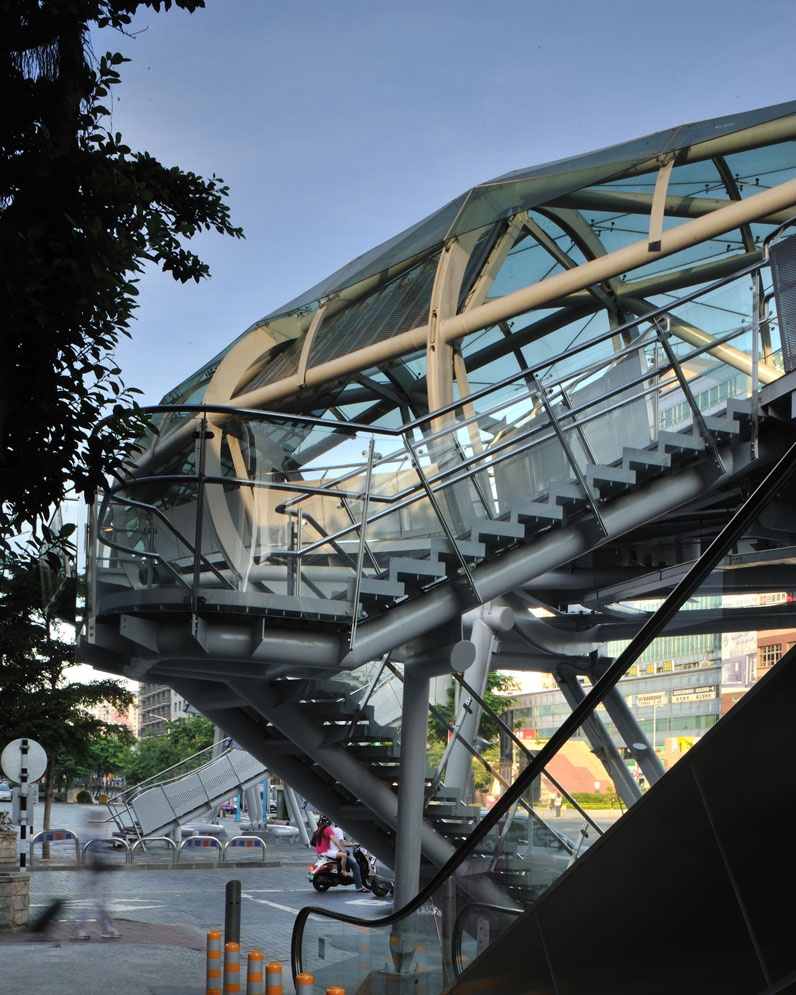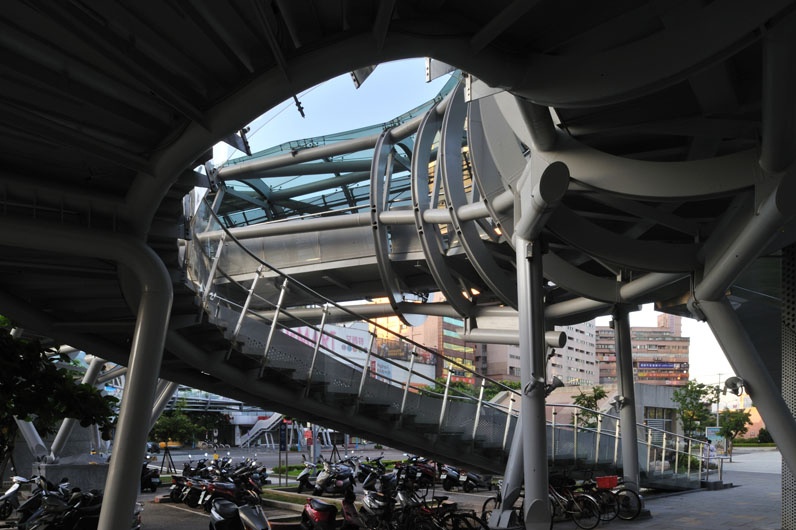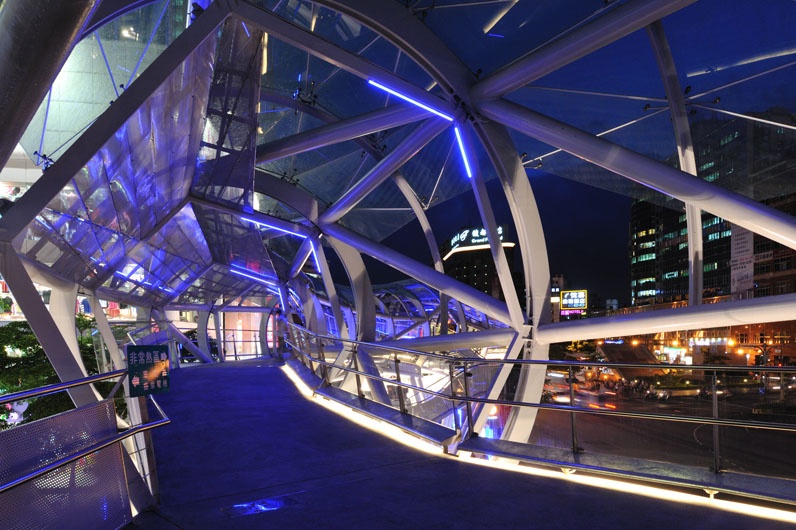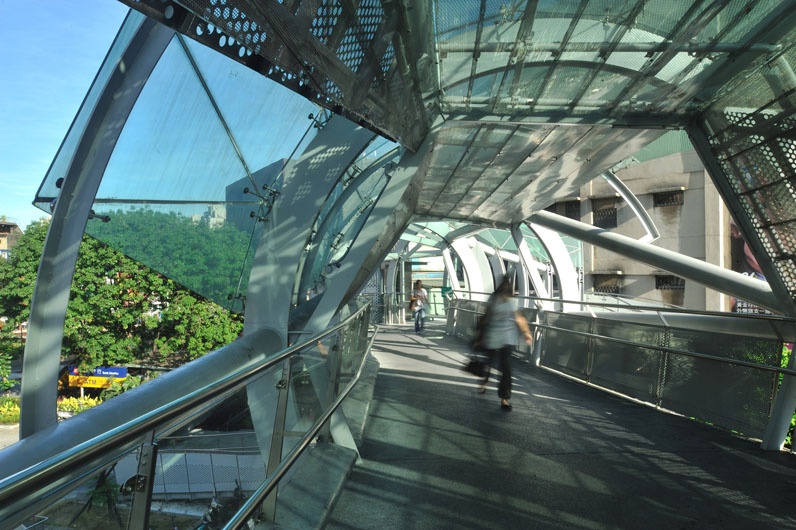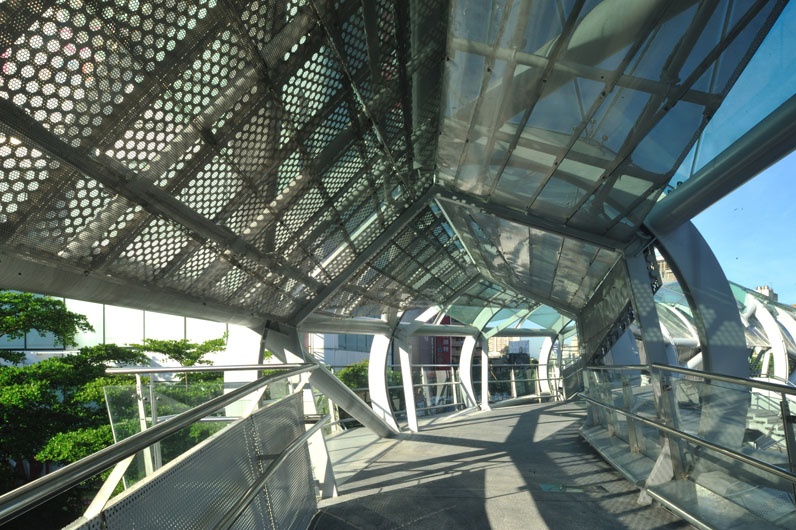
Banqiao Wandering Dragon
Urban activities flow like swirling currents, where the speed of the flow generates opportunities for pausing, meandering, and enjoying the scenery based on the size of the stones, undulating terrain, and steep slopes.
The site is located in the old city area of Banqiao City, adjacent to the County Citizen Boulevard and the bustling commercial district, while bordering the City Museum and the Banqiao City Hall to the north. The western area includes cultural resources like the Lin Family Garden, and to the east lies the Taipei Sub-Center and the integrated Banqiao Station, serving the four major transportation networks. Additionally, it serves as both a local gateway and a guide at the entrance/exit of the Fuzhong MRT Station. The Lin Family Garden, with its century-old history and profound cultural significance, is a 160-year-old treasure of Banqiao.
This project aims to break away from traditional pedestrian bridge concepts and develop multiple meanings of a "bridge" that correspond to the overall urban culture.
Named "Banqiao Wandering Dragon," the bridge embodies the representative local cultural image of the Lin Family Garden while presenting a modern interpretation. It appropriately transforms and extracts its architectural imagery, enabling residents to delve deeper into cultural recognition and identification, such as through framed views, borrowed scenery, connected corridors, ice-cracked lattice windows, and resting places for visitors. Among these, the lattice texture is used as a framework, covered with transparent nets to exhibit the cultural, lightweight, and transparent characteristics of the bridge.
"Taiwan already has beautiful individual landscapes, what we need is a beautiful connection."
"Banqiao Wandering Dragon" is a pedestrian footbridge accommodating pedestrians, persons with disabilities, wheelchairs, and bicycles. It starts from Exit 2 of the Fuzhong Station of the Ban Nan Line, spans across County Citizen Boulevard, and connects to the "Very Hot District." The concept of a "scenic corridor bridge" is interpreted as imagining a stroll within a garden corridor. The bridge uses framing and borrowed scenery techniques to incorporate the external scenery, gardens, squares, and city streets onto the bridge, creating the grandest and most beautiful garden experience. It allows free passage, where one can choose to stand and look out from the bridge or take a ramp to visit the City Museum, then cross the County Citizen Boulevard to explore the bustling shopping mall. It is a pedestrian bridge that embodies culture, poetry, art, and creativity.
The bridge body is constructed using tubular and linear steel pipes, which not only provide shading but also absorb the surrounding picturesque scenery and greenery. The overall appearance molds the streamlined bridge structure with the lattice window texture as the starting point. The bridge structure is formed by several rotating hexagonal tubular elements, interlinked in a spiral fashion. The main beam and column structures extend from the ground like sculptures, while the secondary framework consists of linear steel pipes that intertwine around the bridge, creating a lightweight, shaded shelter, and presenting a transforming spatial effect.
The tubular structures extend to the ground to form structural columns, while the bridge integrates sunshades and covered skin layers, enriching the pedestrian experience with changing light and shadow. By applying the concept of fish gathering in a swirling vortex, the bridge not only serves as a passageway but also offers spaces for people to pause, chat, relax, and exchange information. It transforms the bridge from merely a bridge into a unique "container" within the urban landscape—an architectural, artistic, and sculptural landmark that forms a harmonious urban space with the new City Hall and nearby squares and pathways. It is more than just a connection.
The significance of the bridge lies not only in its role as a connection but also as a platform for people to pause, rest, and interact in the city. In the centennial-old urban environment of Banqiao, various elements of the urban environment interweave—culture, history, art, and modernization. Public facilities like the bridge are not merely functional connectors; they hold a broader meaning in fostering citizen interactions, responding to changing weather conditions, and enriching the visual experiences of passersby. Its role within the city extends to the safety of citizens, acting as a vital commuting hub. In the busy intersections and entrances/exits of the MRT station, traffic becomes a priority, and the vertical structure of the bridge integrates solutions for daily issues like motorcycle parking, boarding, and crossing roads, establishing order within the area."
The site is located in the old city area of Banqiao City, adjacent to the County Citizen Boulevard and the bustling commercial district, while bordering the City Museum and the Banqiao City Hall to the north. The western area includes cultural resources like the Lin Family Garden, and to the east lies the Taipei Sub-Center and the integrated Banqiao Station, serving the four major transportation networks. Additionally, it serves as both a local gateway and a guide at the entrance/exit of the Fuzhong MRT Station. The Lin Family Garden, with its century-old history and profound cultural significance, is a 160-year-old treasure of Banqiao.
This project aims to break away from traditional pedestrian bridge concepts and develop multiple meanings of a "bridge" that correspond to the overall urban culture.
Named "Banqiao Wandering Dragon," the bridge embodies the representative local cultural image of the Lin Family Garden while presenting a modern interpretation. It appropriately transforms and extracts its architectural imagery, enabling residents to delve deeper into cultural recognition and identification, such as through framed views, borrowed scenery, connected corridors, ice-cracked lattice windows, and resting places for visitors. Among these, the lattice texture is used as a framework, covered with transparent nets to exhibit the cultural, lightweight, and transparent characteristics of the bridge.
"Taiwan already has beautiful individual landscapes, what we need is a beautiful connection."
"Banqiao Wandering Dragon" is a pedestrian footbridge accommodating pedestrians, persons with disabilities, wheelchairs, and bicycles. It starts from Exit 2 of the Fuzhong Station of the Ban Nan Line, spans across County Citizen Boulevard, and connects to the "Very Hot District." The concept of a "scenic corridor bridge" is interpreted as imagining a stroll within a garden corridor. The bridge uses framing and borrowed scenery techniques to incorporate the external scenery, gardens, squares, and city streets onto the bridge, creating the grandest and most beautiful garden experience. It allows free passage, where one can choose to stand and look out from the bridge or take a ramp to visit the City Museum, then cross the County Citizen Boulevard to explore the bustling shopping mall. It is a pedestrian bridge that embodies culture, poetry, art, and creativity.
The bridge body is constructed using tubular and linear steel pipes, which not only provide shading but also absorb the surrounding picturesque scenery and greenery. The overall appearance molds the streamlined bridge structure with the lattice window texture as the starting point. The bridge structure is formed by several rotating hexagonal tubular elements, interlinked in a spiral fashion. The main beam and column structures extend from the ground like sculptures, while the secondary framework consists of linear steel pipes that intertwine around the bridge, creating a lightweight, shaded shelter, and presenting a transforming spatial effect.
The tubular structures extend to the ground to form structural columns, while the bridge integrates sunshades and covered skin layers, enriching the pedestrian experience with changing light and shadow. By applying the concept of fish gathering in a swirling vortex, the bridge not only serves as a passageway but also offers spaces for people to pause, chat, relax, and exchange information. It transforms the bridge from merely a bridge into a unique "container" within the urban landscape—an architectural, artistic, and sculptural landmark that forms a harmonious urban space with the new City Hall and nearby squares and pathways. It is more than just a connection.
The significance of the bridge lies not only in its role as a connection but also as a platform for people to pause, rest, and interact in the city. In the centennial-old urban environment of Banqiao, various elements of the urban environment interweave—culture, history, art, and modernization. Public facilities like the bridge are not merely functional connectors; they hold a broader meaning in fostering citizen interactions, responding to changing weather conditions, and enriching the visual experiences of passersby. Its role within the city extends to the safety of citizens, acting as a vital commuting hub. In the busy intersections and entrances/exits of the MRT station, traffic becomes a priority, and the vertical structure of the bridge integrates solutions for daily issues like motorcycle parking, boarding, and crossing roads, establishing order within the area."
| Category | Public |
|---|---|
| Location | Banqiao, New Taipei City |
| Completion | 2010 |
01 / 10
